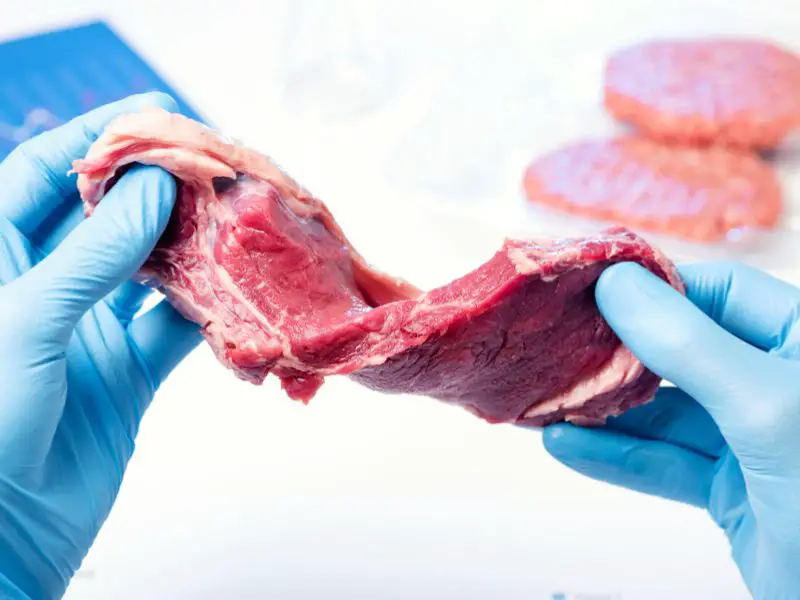The concept of lab-grown, cell-based, cultured meats may seem puzzling, so we’ll address some often-asked questions. Since the first lab-grown burger was created in 2013, the industry has experienced monumental development and several technological advancements. Soon, lab-grown meats will likely be available in your grocery stores.
This article outlines the industry and where it is headed in the near future.

What’s a Lab Grown Meat or Cultured Meat?
A “lab-grown” meat or cultured meat is a food product cultivated in a laboratory from animal cells or tissues using cell culture technology. Scientists take a sample of muscle tissue from an animal and then isolate the muscle stem cells from the sample.
The cells are then placed in specialized nutrient media to grow into a tissue-like mass called a “cultured” muscle piece. These pieces are then placed onto a scaffold to develop muscle fibers and then are matured by feeding them nutrients until they resemble a piece of meat that is fit for human consumption.
History of Lab-Grown Meat
The first burger with a lab-grown patty was prepared by chef Richard McGeown and consumed in London in 2013.
Two years and $325,000 were spent on research, development, and invention to create the burger.
Startups and established food firms have worked tirelessly to lower manufacturing time and costs and make lab-grown burgers and other meats more accessible to the average consumer since the first lab-grown burger was consumed.
Due to the continued research on lab-grown meat, you can purchase a lump of lab-grown meat for as little as $9.80 today.
What’s Bad About Lab-Grown Meat?
Some laboratory-grown meat contains fetal bovine serum, an animal byproduct.
After slaughtering pregnant cows, slaughterhouses get fetal bovine serum by collecting blood from the unborn calves.
Also, the cancer-promoting qualities of cells that multiply exponentially in vitro stand out as a possible health risk. Consuming lab-grown meat derived from defective cell lines may have detrimental repercussions on the human body; however, the consequences remain unclear.

What’s Good About Lab-Grown Meat?
Cultured meat is praised for its promise to save animal lives, reduce greenhouse gas emissions, and solve food insecurities worldwide.
Factory agriculture farming is a massive problem. It takes a lot of energy, contributes to air, water, and land contamination, and is responsible for 37 percent of the world’s total methane emissions, which are a factor in climate change. In addition, traditional factory farming procedures are extremely vicious to animals.
Suppose there is one thing that the pandemic has taught us. It’s that widespread food insecurity affects one in nine individuals in the United States, while globally, roughly 2 billion people are at risk of going hungry.
The production of meat in laboratories holds the potential to provide a source of protein that is both kind to the environment and ethically sound.
At least, in theory.
How Do They Grow Meat in Labs?
In facilities known as bioreactors, scientists grow meat without slaughtering animals. Bioreactors use animal cells, often taken from a live animal, to produce the required meat cells. The cells are grown in a nutrient-rich environment and fed a nutrient solution.
Within a few days, the cells begin to differentiate and grow into a tissue-like mass called a “cultured” muscle piece. These pieces are then placed onto a scaffold to develop muscle fibers and then are matured by feeding them nutrients until they resemble a piece of meat that is fit for human consumption. When the piece of meat is ready to be eaten, it is placed in a bioengineered casing that resembles a natural muscle fiber casing.

What’s in Store for the Future of Cultured Meat?
For the time being, the idea of genetically modifying meat is hindered by regulatory differences between the FDA and the USDA. Long-term, large-scale manufacturing of cultured meat would need cost-effective and resource-efficient energy infrastructure.
Additionally, it would not replace industrial farming soon. The current goal of cultured meat is to “augment, not disrupt” and “coexist, respect consumer traditions – Steve Myrick.
Concerning long-term sustainability, there are no definitive answers (although there is a fair amount of uncertainty).
Lab-grown meat is “not inherently better or worse, but different.” Dr. Mattick says. It’s hardly a slam dunk, but it has the potential.
Author’s Note
Cultured meat is inevitable if we continue having billions of people on this planet. Through time, we’re going to see cultured meat as something normal, just like we have soy milk or almond milk. Moreover, the idea of eating lab-grown meats may appeal to many consumers due to environmental reasons; however, these reasons should be weighed against the potential risks before jumping on the bandwagon.
To learn more about healthier options, check out these articles about 10 Healthy Fast Food Options Across The US and 13 Healthy Sweet Snacks.

